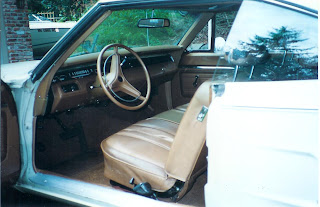

My dad recently dug up the few, precious photos we took of my first car, a 1970 Plymouth Satellite. I bought it in 1997 for $3,500 and sold it a couple of years later – a decision that literally haunts my dreams.
By any objective measure it was a terrible car. The large (by current standards) 318 V8 engine was rated at 230 gross horsepower, which translates to maybe 180 as it is measured today. This afforded the roughly 3,500 lbs. car a rare combination of poor acceleration and woeful fuel consumption that is unique to American automobiles of this vintage. We threw a four-barrel carburetor on and backed it up with dual exhaust, which raised the performance from "embarrassing" to "barely acceptable." All those ponies were herded through a lazy Torqueflite A904 transmission that managed to never find the right gear even with only three to choose from. The four wheel drum brakes had no power assist but still managed to lock up the rear tires at the slightest provocation, sending the car into a sideways slide on Seattle’s rain-slicked streets more times than I’m comfortable admitting. The steering suffered the opposite malady – it was so over-boosted that slight changes in the driver’s mood could turn the spindly plastic wheel 15 degrees in either direction. Luckily at least 30 degrees were required in order to have any influence in the front wheels, which usually responded by squealing obscenities and shooting their hubcaps off in random directions. Occasionally, with much deliberation and forethought, I could coax the great beast to actually turn. As it did so the body would lean to such a severe degree that anything in the trunk would gather enough momentum to actually dent it from the inside, whilst the passengers would glide effortlessly across the slippery vinyl bench seats like air hockey pucks. Its technology was ancient, even for the period, and its dynamics were miserable.
The Satellite’s virtues were more esoteric – more ethereal. It looked great. The somewhat plain cream color was set off by the copper colored top to become something a bit more than the sum of its parts. I was the constant recipient of envious stares and enthusiastic thumbs up. And it sounded mean rumbling up to the high school each morning, a stark contrast to the wheezing Honda Civics and Ford Escorts owned by most of my classmates. I once found a note on the windshield offering to buy it, which is something that has not happened in the entire history of the Toyota Camry.
Most importantly, it was cool. And driving it made me feel cool. It might have even made me be cool. And that’s something I haven’t experienced with any other car made in the last 30 years or so. Today’s cars, with few exceptions, are hopelessly bland and they treat blandness like it is the highest possible automotive virtue. The ultimate expression of this trend is the large plastic cover that now adorns the engine of almost every new car. It serves to protect the delicate owner from engine noise, the possibility of servicing one’s own vehicle and the very unpleasant notion that your transportation is powered by something as unseemly and shameful as internal combustion.
There are small pockets of resistance dotting the automotive landscape but their efforts seem half-hearted. Ford, GM and Dodge have all introduced retro-styled resurrections from their glory days. The updated Mustang, Camaro and Challenger are attempts to recapture some of that elusive coolness that we lost somewhere between the oil embargoes and 5-mph bumper regulation. Their performance is orders of magnitude better than their forbears but in appearance they are only caricatures, with cartoonish proportions and exaggerated features – certainly recognizable, but the overall effect is one of trying too hard. And trying too hard to be cool is about as far from cool as you can be.
It’s hard to say whether cars of that era were intrinsically cool or if the passage of time has made them so. Still I can’t to picture my (as of yet unborn) son cruising in a 2-door Honda Accord 30 years from now and garnering much attention. One thing is for sure: cool can’t be manufactured.
Today I drive a Miata, which is a fantastic car for being everything that the Plymouth was not. But every once in a while I have dream where she’s mine again and I still troll craigslist and eBay just about every night hoping to find another Satellite. Unfortunately their resemblance to contemporary Road Runners and GTXs have made them ideal for creating “tribute” cars and prices are now beyond what I can reasonably afford. That’s okay – it’s probably cooler in my memories than it would be in my driveway.
-Jordan



No comments:
Post a Comment